Nvidia makes some of the best graphics cards you can buy, but two have been the topic of much debate over the past several weeks: the RTX 4060 and RTX 4060 Ti. These two GPUs are meant to hit the mainstream market for Team Green, though they struggle to hit that mark to varying degrees.
We put both on the test bench to see if you should buy the RTX 4060 or the RTX 4060 Ti. If you want a more in-depth look, make sure to read our RTX 4060 review and RTX 4060 Ti review.
Specs
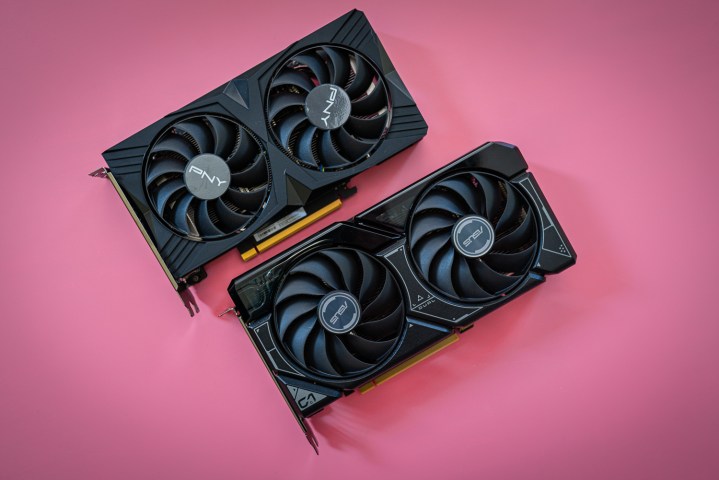
We’re concerned primarily with the new cards here, the RTX 4060 Ti and RTX 4060, but it’s helpful to place them in the context of the products they’re replacing. As you can see, these new 40-series cards aren’t a major leap ahead in raw performance. In fact, both the RTX 4060 Ti and RTX 4060 actually have fewer CUDA cores than their predecessors. The RTX 4060 Ti even features less ray tracing and Tensor cores than the RTX 3060 Ti. They also have a very different configuration in terms of memory subsystems.
That doesn’t mean there isn’t a significant difference between the RTX 4060 Ti and the RTX 4060 though. The RTX 4060 Ti has 29% more CUDA cores than the RTX 4060. That’s an even bigger delta than what existed between the RTX 3060 Ti and the RTX 3060. There’s also a huge difference in total graphics power (TGP), with the RTX 4060 Ti drawing up to 30% more power than the RTX 4060.
| RTX 4060 Ti | RTX 4060 | RTX 3060 Ti | RTX 3060 | |
| Architecture | Ada Lovelace | Ada Lovelace | Ampere | Ampere |
| Process node | TSMC N4 | TSMC N4 | Samsung 8nm | Samsung 8nm |
| CUDA cores | 4352 | 3072 | 4864 | 3584 |
| Ray tracing cores | 32 cores (3rd-gen) | 24 (3rd-gen) | 38 cores (2nd-gen) | 28 cores (2nd-gen) |
| Tensor cores | 128 cores (4th-gen) | 96 (4th-gen) | 152 cores (3rd-gen) | 112 cores (3rd-gen) |
| Base clock speed | 2.31GHz | 1.83GHz | 1.41GHz | 1.32GHz |
| Boost clock speed | 2.54GHz | 2.46GHz | 1.76GHz | 1.78GHz |
| VRAM | 8/16GB GDDR6 | 8GB GDDR6 | 8GB GDDR6/6X | 8/12GB GDDR6 |
| L2 cache | 32MB | 28MB | 4MB | 3MB |
| Bus width | 128-bit | 128-bit | 256-bit | 192-bit |
| Total Graphics Power (TGP) | 160W/165W | 115W | 200W | 170W |
| Price | $399 / $499 | $299 | $399 | $329 |
What remains similar in both is the memory. You get the option for 8GB or 16GB of VRAM with the RTX 4060 Ti, but both use a very large L2 cache to reduce traffic to the frame buffer. Nvidia says this improves overall bandwidth, though our testing proves that both the RTX 4060 and RTX 4060 Ti are limited by their 8GB frame buffer.
Performance
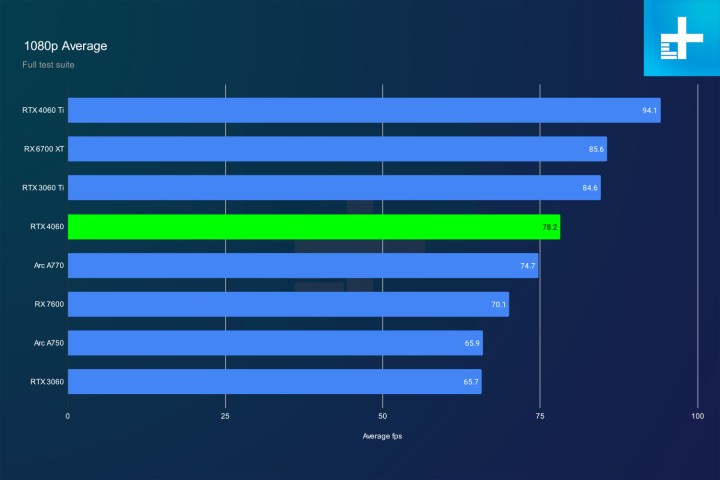
We know it. You know it. The RTX 4060 Ti is faster than the RTX 4060. The question is by how much. At 1080p across our full test suite, including ray tracing benchmarks, the RTX 4060 is about 20% faster. That’s a big jump, but keep in mind that it’s also 33% more expensive. Frankly, it shows how out of sorts the pricing is for both of these GPUs, with last-gen’s RTX 3060 Ti and RX 6700 XT offering higher performance than the RTX 4060 for around the same price.

Looking at individual games, the RTX 4060 Ti is ahead by a solid margin in most titles. The only exception here is The Last of Us Part One, where the two GPUs are almost identical. This is a showcase of what the constrained memory interface is doing, limiting the more powerful RTX 4060 Ti from showing off its full power.

Where the RTX 4060 Ti really shoots ahead is ray tracing, though. It’s around 50% faster in Cyberpunk 2077 with
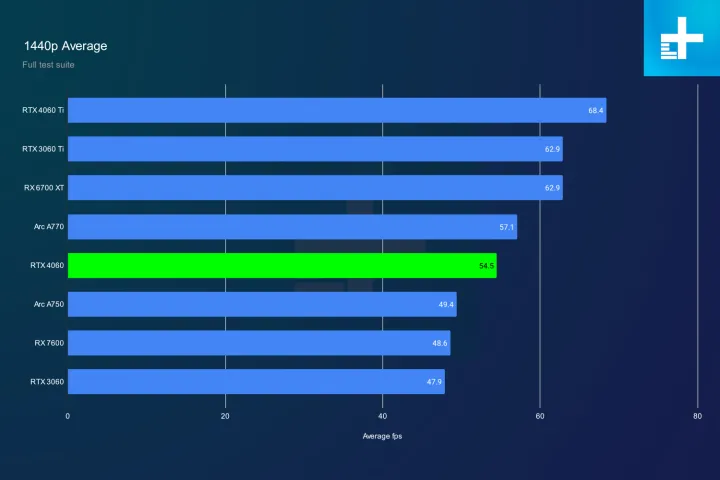
Nvidia has billed both cards as 1080p GPUs, but what happens when we jump up to 1440p? The RTX 4060 Ti, with its massive core advantage, shoots ahead with a 25% lead overall. It’s not a great 1440p graphics card due to its memory interface, but there’s no denying the RTX 4060 Ti is a better choice than the RTX 4060 for this resolution.
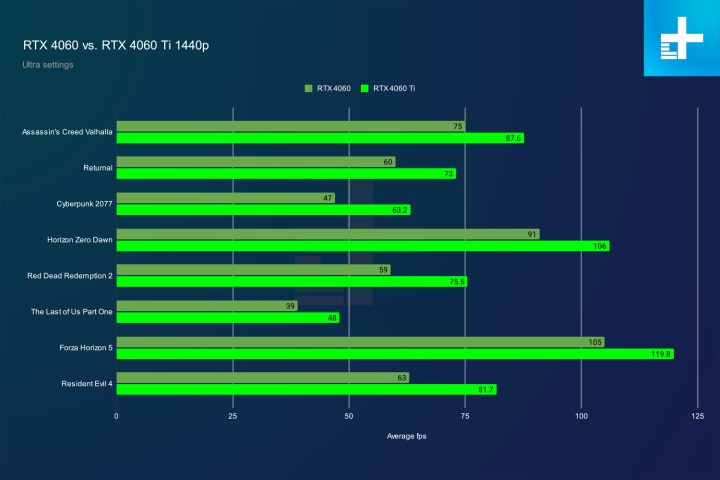
Although the RTX 4060 Ti is indeed faster here, it really shoots ahead due to ray tracing. You can see in my standard test suite above that the advantages aren’t as stark as they were at 1080p, as both GPUs are dealing with fewer frames overall.

Ray tracing is a different beast. Again, the RTX 4060 Ti is nearly twice as fast in Cyberpunk 2077, and 30% faster in Resident Evil 4. It also leads by 30% in Returnal, despite there being a smaller gap between the two GPUs in this game at 1080p.
So, what’s the problem? The RTX 4060 Ti leads, but it sits in an awkward spot. It’s too expensive for a premium 1080p gaming experience, but it doesn’t quite hit the mark for 1440p, either. Sure, the RTX 4060 is behind, and even more so at 1440p, but it’s priced as a premium 1080p graphics card, and it mostly delivers on that experience.
RTX features

The RTX 4060 Ti and RTX 4060 both have access to the same RTX features that have been included in other 40-series cards. Notably, the 4th-gen Tensor cores allow them to use DLSS 3 with frame generation. Frame generation is proving to provide the biggest uplift in the games where it’s been implemented by developers.
It’s hard to compare apples to apples with previous generations, though. The RTX 4060, for example, has fewer RT cores and Tensor cores than the RTX 3060, but according to Nvidia, the RTX 4060 still produces better ray tracing and DLSS performance. Nvidia claims the larger L2 cache improves RTX performance in particular as well.
Availability and price
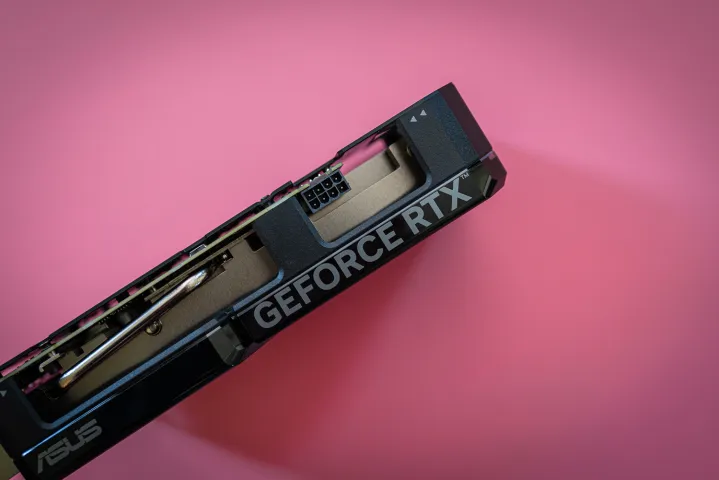
The price difference between the RTX 4060 Ti and RTX 4060 is $100; $399 versus $299. This is already a bigger difference in price than there was between the RTX 3060 Ti and RTX 3060. Based on our testing, that larger gap in price is likely due to a larger gap in performance — the RTX 4060 is quite a way behind the RTX 4060 Ti.
Of course, the 16GB version of the RTX 4060 Ti adds another $100, making for a $200 difference between the cards. The only card that got a first-party Founders Edition is the RTX 4060 Ti 8GB. The others are available exclusively through board partners.
Value is hard to access here because both cards are, frankly, poor value. The RTX 4060 is definitely more reasonable considering it unlocks features like DLSS 3 for $100 less. You’re getting more performance with the RTX 4060 Ti, but unfortunately, not a larger frame buffer for games like The Last of Us Part One.
We can say that the $500 RTX 4060 Ti almost certainly won’t be worth it. We don’t have the card in hand yet, but it’s nearing the price of the RTX 4070, which is somewhere around 35% faster. The extra VRAM will certainly help in some games, but it’s important to remember that the 16GB RTX 4060 Ti is the same GPU under the hood. In many games, it’ll perform exactly as the $400 version does.
RTX 4060 vs. RTX 4060 Ti: which should you buy?

Between the two cards, we recommend most people stick with the RTX 4060. It’s not great, but it hits the mark of a 1080p GPU in terms of pricing much more than the RTX 4060 Ti does.
That conversation changes if you have $400 to spend on a GPU, though. There aren’t a lot of compelling options at that price. AMD has its RX 6700 XT for around $330, which is great for that price, but the RTX 4060 Ti still has some advantages over it.




